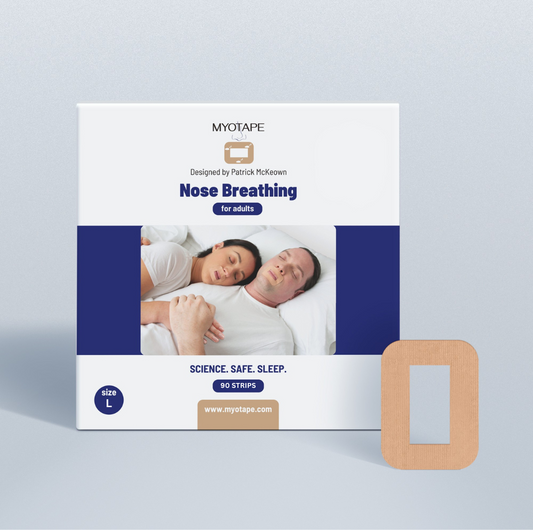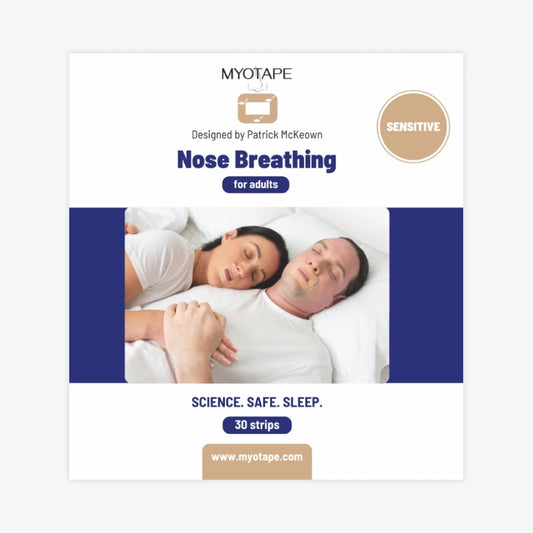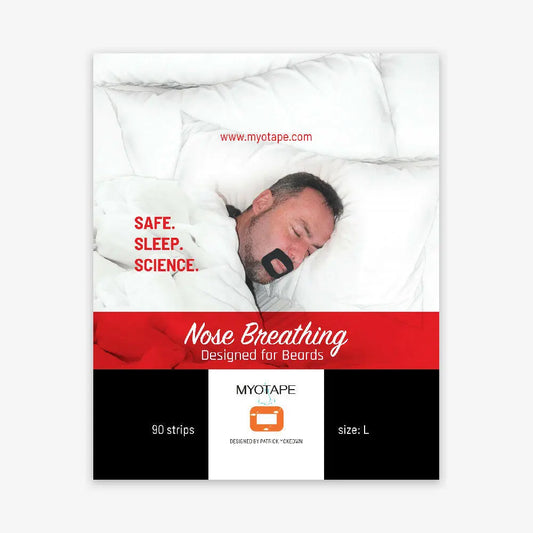Breathing comes naturally, but breathing well is something you can get better at doing. If you’re tired of waking up with a dry mouth, struggling with heavy breathing, or wishing you had more energy throughout the day, you’re not alone.
Many people don’t realize how much their breathing habits can impact their sleep, mood, and overall health. The good news is that with a few simple changes, you can start breathing better and feeling better, too.
In this article, you’ll find easy, practical tips for better breathing, both day and night, so you can enjoy deeper sleep, more energy, and a healthier life. But first, what does healthy breathing mean?
What Does It Mean to Breathe Better?
Most of us rarely think about our breathing unless we’re out of breath. But just because breathing happens automatically doesn’t mean we’re always doing it in the healthiest way.
Many people develop habits like breathing through the mouth, taking quick breaths, or using only the upper chest. These habits can actually make us feel worse over time.
Signs of poor breathing patterns
Breathing problems often go unnoticed until they cause real discomfort. You might feel tired, anxious, or short of breath and not realize your breathing is part of the problem. These issues are often caused by dysfunctional breathing patterns, which can include:
- Breathing too fast or too deeply (hyperventilation)
- Breathing mostly with the upper chest instead of the diaphragm
- Holding your breath or sighing frequently
- Breathing through the mouth instead of the nose
These patterns are surprisingly common and can be triggered by stress, anxiety, asthma, or even just daily habits. Research shows that almost 1 in 10 adults have some form of dysfunctional breathing, and the numbers are even higher in people with asthma or anxiety.
How poor breathing affects your body
When you breathe too much or too quickly, especially through your mouth, your body actually gets less oxygen where it’s needed. This can lead to a drop in carbon dioxide levels in your blood, which affects how oxygen is delivered to your organs and muscles. Over time, poor breathing can contribute to problems like:
- Fatigue and poor concentration
- Restless sleep or waking up with a dry mouth
- Tightness in the chest or frequent sighing
- Heavy breathing, even at rest
- Muscle aches, headaches, or dizziness
- Increased anxiety or panic attacks.
The benefits of healthy breathing
Healthy breathing involves breathing quietly and gently through your nose, using your diaphragm (located in your belly, not just your chest), and taking a natural pause after exhaling. When you breathe this way, you:
- Get more oxygen to your body
- Feel calmer and more focused
- Sleep better and wake up refreshed
- Reduce feelings of breathlessness, anxiety, and fatigue
How to tell if you’re breathing well
Take a moment to notice your breathing right now. Are you breathing through your nose or mouth? Is your belly moving, or just your chest? Are your breaths fast and noticeable, or slow and gentle? Healthy breathing is almost silent, characterized by soft belly movement and a pause after each exhalation.
Learning to breathe better is about becoming aware of your habits and making small changes. Now, let us find out 10 tips that can help you breathe better.
10 Tips to Help You Breathe Better Today

Below are some practical ways to ensure you become better at breathing:
1. Switch to nasal breathing
The foremost tip for healthy breathing is to breathe through your nose. Nasal breathing is how our bodies are designed to function best, it filters, warms, and humidifies the air before it enters your lungs, making each breath more efficient.
Breathing through your nose also helps your body produce nitric oxide, which supports your immune system and improves oxygen delivery.
Nasal breathing naturally slows your breath and encourages the use of your diaphragm. This not only calms your mind but also ensures your lungs and tissues receive more oxygen.
Studies show that nasal breathing can increase oxygen uptake by up to 20 percent compared to mouth breathing.
To begin, simply pay attention to your breath and gently close your mouth, allowing the air to flow in and out through your nose. If your nose feels blocked, practice slow, gentle nasal breaths.
Over time, this can help keep your airways clear. Making nasal breathing your default is one of the most effective ways to help you breathe better every day. It will also ensure that your sense of smell functions optimally.
2. Avoid mouth breathing
In contrast, mouth breathing can lead to a range of health issues. Breathing through your mouth bypasses your nose’s natural filtration, leaving you more exposed to allergens and irritants.
It also dries out your mouth, which can cause bad breath, dental problems, and even disrupt your sleep.
Chronic mouth breathing is linked to snoring, poor sleep quality, and can even affect facial development in children.
Many people do not realize they are mouth breathing, especially at night, but signs include waking up with a dry mouth or frequent snoring.
To break this habit, try to keep your lips gently closed during the day and address any nasal congestion with simple remedies, such as saline rinses.
At night, a gentle aid like MyoTape can help train your mouth to stay closed. Making this change supports healthier breathing and overall wellbeing.
3. Practice diaphragm breathing: slow, light, and deep
Another key tip for better breathing is to use your diaphragm, focusing on slow, light, and deep breaths.
Diaphragmatic breathing like the Buteyko Method helps normalize your breathing pattern, improves oxygen delivery, and calms your nervous system. It is easy to practice, just place a hand on your belly and feel it gently rise and fall with each breath.
Aim to slow your breathing to about six to ten breaths per minute, making each breath soft and quiet.
You may notice a gentle air hunger, which is a sign you are building healthy carbon dioxide levels in your blood, a crucial part of efficient oxygen delivery.
Practice this technique daily, especially when you feel stressed or out of breath. With time, slow and light diaphragm breathing will become natural, helping you feel more relaxed, focused, and energized throughout your day.
Breathing exercises can also help children sleep better at night.
4. Clear your nose and airways
Nasal congestion can turn every breath into a challenge, especially during allergy season or at night. Saline rinses gently wash away irritants and excess mucus, while a humidifier keeps the air moist, making it easier for your nose to do its job.
If you’re struggling with a blocked nose, the Buteyko Nose Unblocking Exercise offers a natural solution. By briefly holding your breath and nodding your head, you increase carbon dioxide in your blood, which signals your nasal passages to open.
This exercise not only relieves congestion but also encourages more efficient nasal breathing.
Reducing allergens in your environment and managing allergies are also important tips to help with breathing.
5. Maintain a healthy lifestyle
Your daily choices have a direct impact on your breathing health. Regular exercise, whether it’s walking, cycling, or even gentle stretching, helps strengthen your lungs and supports efficient oxygen use.
A balanced diet packed with colorful fruits and vegetables nourishes your body and keeps your immune system strong.
Steering clear of smoking and secondhand smoke is crucial. Tobacco and pollutants irritate your airways, reduce lung function, and increase your risk of respiratory problems.
Furthermore, good posture supports healthy breathing. Sit or stand tall with relaxed shoulders to allow your diaphragm to move freely.
6. Improve indoor air quality
The air inside your home can be filled with invisible triggers that make breathing harder, dust, pet dander, mold, and chemicals from cleaning products all play a role.
Air purifiers can help remove these particles, while opening windows regularly brings in fresh air and reduces indoor pollution.
Frequent cleaning, especially of carpets and bedding, cuts down on allergen buildup. Choosing fragrance-free or natural cleaning products also helps minimize exposure to harsh chemicals that can irritate your lungs.
With cleaner air, your lungs can work more efficiently, and you’ll likely notice a difference in your comfort and energy.
7. Stay hydrated
Dry airways make it harder for your body to filter out dust and germs, and can leave you feeling tired or congested.
Drinking enough water each day helps keep the lining of your nose and lungs moist, making it easier to clear out irritants and breathe easily.
Instead of waiting for thirst, get into the habit of sipping water regularly. This supports your body’s natural defenses and ensures that your respiratory system functions at its best.
8. Manage stress and anxiety
Stress and anxiety can quickly disrupt healthy breathing, often causing shallow, rapid breaths or even a sense of breathlessness.
When you’re tense, your body naturally shifts into a “fight or flight” mode, which can make breathing feel harder and less efficient.
Simple relaxation techniques can help restore calm and steady your breath. Try slow, deep breathing by inhaling gently through your nose, letting your belly rise, then exhaling slowly through your mouth.
Even just a few minutes of this practice can settle your mind and body. Activities like gentle stretching, meditation, or listening to calming music can also help regulate your breathing patterns.
9. Practice good sleep habits
Nighttime can be a challenge for those who struggle with breathing. Sleeping on your back may worsen snoring and mouth breathing, while side-sleeping can help keep your airways open and support nasal breathing.
If you tend to breathe through your mouth at night, consider gentle MyoTape to encourage nasal breathing while sleeping and reduce dryness or congestion.
Maintaining a regular sleep schedule and winding down before bed can further promote restful, uninterrupted breathing.
10. Seek professional help for persistent symptoms
If you find yourself struggling with difficult or labored breathing that doesn’t improve with self-care, it’s essential to consult a healthcare professional. Persistent breathlessness, frequent episodes of shortness of breath, or ongoing discomfort may indicate an underlying condition that requires attention.
A doctor can help identify the cause of your poor breathing and suggest the best treatment, whether it’s for allergies, asthma, sleep apnea, or another issue. Early intervention can help prevent complications and improve your overall well-being more quickly.
Don’t hesitate to seek advice if you’re concerned about your breathing.
MyoTape Makes It Easy for You to Breathe Better
Nasal breathing is essential. MyoTape helps you achieve it. Designed by world-renowned expert Patrick McKeown, MyoTape gently trains your lips to stay together, whether you are awake or asleep. This encourages nasal breathing, improves sleep, and boosts your energy.
Unlike other mouth tapes, MyoTape surrounds the lips without completely covering them. You can still open your mouth if needed. It is safe, comfortable, and highly effective.
Select the MyoTape that best suits your needs. We offer options for mouth tape for adults, kids, sensitive skin, and those with facial hair.








